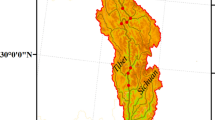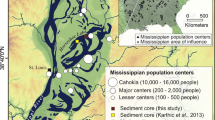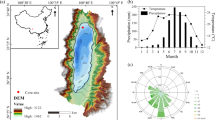Abstract
Fish introduction, eutrophication and disappearance of aquatic vegetation are important disturbances of aquatic ecosystems, especially in plateau lakes, which are generally considered to be very vulnerable. Fish were introduced to Lake Dianchi, a eutrophic plateau lake in southwest China, in the late 1950s and 1970s. After the introduction, invasive fish became the dominant species, and the total fish yield increased. Meanwhile, the trophic level of Lake Dianchi had a tendency to increase in the past decades because of the increases in human activities in the watershed area. In addition, the area of aquatic vegetation decreased from more than 90 to 1.8% of the lake area from the 1950s to 2000. This study investigated the effects of fish introduction, eutrophication and aquatic vegetation on the diatom community of Lake Dianchi by examining the changes of microfossil diatom assemblage and abundance. Results showed that the absolute abundance and diatom assemblages changed after fish were introduced. The endemic species, Cyclotella rohomboideo-elliptica, disappeared with the introduction of fish and increasing trophic levels after 1958. Fragilaria crotonensis entered into the lake with the introduction of fish and gradually thrived in the lake after 1958. Diatom species numbers also decreased gradually from 21 to 9 from the past to present. Epiphytic diatoms disappeared with the decrease of aquatic vegetation after 1985. Our study indicated that eutrophication was the most important process determining diatom abundance, and fish introduction was a secondary process determining diatom abundance, while aquatic vegetation had a more important role in structuring the diatom community in this eutrophic plateau lake.


Similar content being viewed by others
References
Appleby PG, Oldfield F (1978) The calculation of 210Pb dates assuming a constant rate of supply of unsupported 210Pb to sediment. Catena 5:1–8
Appleby PG, Nolan PJ, Battarbee DW (1986) 210Pb dating by low background gamma counting. Hydrobiologia 141:21–27
Battarbee RW (1986) Diatom analysis. In: Berglund BE (ed) Handbook of holocene palaeoecology and palaeohydrology. Wiley, Chichester, pp 527–570
Bjöjk-Ramberg S, Änell C (1985) Production and chlorophyll concentration of epipelic and epilithic algae in fertilized and nonfertilized subarctic lakes. Hydrobiologia 126:213–219
Canfield DE, Hoyer MV (1992) Aquatic macrophytes and their relation to limnology of Florida Lakes. Bureau of Aquatic Plant Management, Florida Department of Natural Resources, Florida
Cui YD, Liu XQ, Wang HZ (2008) Macrozoobenthic community of Fuxian Lake, the deepest lake of southwest China. Limnologica 38:116–125
Edlund MB, Stoermer EF, Pilskaln CH (1995) Siliceous microfossil succession in the recent history of two basins in Lake Baikal, Siberia. J Paleolimnol 14:165–184
Hall RI, Smol JP (1999) Diatoms as indicators of lake eutrophication. In: Stoermer EF, Smol JP (eds) The diatoms: applications for the environmental and earth science. Cambridge University Press, London, pp 128–168
Hansson LA (1992) Factors regulating periphytic algal biomass. Limnol Oceanogr 33:121–128
Jeppesen E, Jensen JP, Kristensen P, Søndergaard M, Mortensen M, Sortkjaer O, Olrik K (1990) Fish manipulation as a lake restoration tool in shallow, eutrophic, temperate lakes. II. Threshold levels, longterm stability and conclusions. Hydrobiologia 200(201):219–227
Jeppesen E, Ma Søndergaard, Mo Søndergaard, Christoffersen K (1998) The structuring role of submerged macrophytes in lakes. Springer, New York
Jeppesen E, Jensen JP, Ma Søndergaard, Lauridsen T, Landkildehus F (2000) Trophic structure, species richness and biodiversity in Danish lakes: changes along a phosphorus gradient. Freshw Biol 45:201–218
Kociolek JP, Spaulding SA (2000) Freshwater diatom biogeography. Nova Hedwigia 71:223–241
Krammer K, Lange-Bertalot H (1988) Süßwasserflora von Mitteleuropa. Bacillariophyceae 1. Tei: Naviculaceae. Gustav Fisher Verlag, Jena
Krammer K, Lange-Bertalot H (1991) Süßwasserflora von Mitteleuropa. Bacillariophyceae 4. Tei: Achnanthaceae, Kritische Erganzungen zu Navicula (Lineolatae) und Gomphonema Gesamtliterturverzeichnis Tei 1-4. Gustav Fisher Verla, Jena
Lange-Bertalot H (2001) Navicula sensu stricto, 10 genera separated from Navicula sensu lato, Frustulia. In: Lange-Bertalot H, Gantner Verlag ARG, Ruggell KG(eds) Diatoms of Europe: diatoms of the European Inland waters and comparable habitats 2, pp 526
Leibold MA (1989) Resource edibility and the effects of predators and productivity on the outcome of trophic interactions. Am Nat 134:922–949
Ley S, Yu M, Li K, Ceng C, Chen J, Gao P, Huang H (1963) Limnological survey of the lakes of Yunnan Plateau (in Chinese). Oceanologia et Limnologia Sin 5(2):87–114
Li W (2001) The distribution of surviving Sinocyclocheilus grahami and other endemic fishes in Dianchi Lake Valley (in Chinese). J Jishou Univ 22:72–74
Li D (2003) The ecological analysis of the resources dynamics of Neosalanx taihuensis in Dianchi Lake (in Chinese). Trans Oceanol Limnol 2:69–73
Li YL, Gong Z, Shen J (2007) Freshwater diatoms of eight lakes in the Yunnan Plateau, China. J Freshw Ecol 22:169–171
Liu Z, Zhu S (1994) Food and feeding behavior of ice-fish (Neosalanx taihuensis Chen) in Dianchi Lake (in Chinese). Acta Zool Sin 40:253–261
Luo M, Duan C, Shen X, Yang L (2006) Environmental degradation and loss of species diversity in Dianchi Lake (in Chinese). Mar Fish 28:71–78
Mao Z, Peng W, Wang S, Zhou H (2005) Assessment and control measures for the eutrophication problems of the Dianchi Lake (in Chinese). J China Inst Water Resour Hydropower Res 3:135–142
Meng Y (1999) The development tendency analysis of nitrogen and phosphorous content in Waihai of Dianchi Lake (in Chinese). Yunnan Environ Sci 18:32–33
Nanjing Institute of Geography and Limnology (1989) Environments and sedimentation of fault lakes, Yunnan Province (in Chinese). Science Press, Beijing, pp 1–513
Olsen DM, Dinerstein E (1998) The global 200: a representation approach to conserving the earth’s most biologically valuable ecoregions. Conserv Biol 12:502–515
Qi YZ (1995) Flora Algarum Sinicarum Aquae Dulcis, Tomus IV Bacillariophyta Centricae (in Chinese). Science Press, Beijing
Reavie ED, Hall RI, Smol JP (1995) An expanded weighted-averaging model for inferring past total phosphorus concentrations from diatom assemblages in eutrophic British Columbia (Canada) Lakes. J Paleolimnol 14:49–67
Round FE, Crawford RM, Mann DG (1990) The diatoms biology and morphology of the genera. Cambridge University Press, Cambridge
Rumrich U, Lange-Bertalot H, Rumrich M (2000) Diatoms of the Andes (from Venzuela to Patagonia/Tierra del Fuego), Annotated diatom micrographs. Iconographia Diatomologica, 9. A.R.G. Gantner Verlag K.G
Sarnelle O (1993) Herbivore effects on phytoplankton succession in a eutrophic lake. Ecol Monogr 63:129–149
Scheffer M, Hosper SH, Meijer ML, Moss B, Jeppesen E (1993) Alternative equilibria in shallow lakes. Trends Ecol Evol 8:275–279
Schriver P, Bogestrand J, Jeppesen E, Søndergaard M (1995) Impact of submerged macrophytes on fish zooplankton–phytoplankton interactions: large-scale enclosure experiments in a shallow eutrophic lake. Freshw Biol 33:255–270
Shapiro J (1980) The importance of trophic-level interactions to the abundance and species composition of algae in lakes. In: Barica J, Moore LR (eds) Hypertrophic ecosystems. Junk Publisher, The Hague, pp 105–116
Skuja H (1937) Algae, in Handel-Mazzetti, Symbolae Sinicae. –Botanische Ergebnisse der expedition der Akademic der Wissenschaften in Wien nach Südwest-China. 1914–1918
Stoermer EF, Smol JP (1999) The diatoms: applications for the environmental and earth sciences. Cambridge University Press, London
Tuo Y (2002) Eutrophication of Dianchi and its trend and treatment. Yunnan Environ Sci 21:35–38
Van Donk E, Van de Bund WJ (2002) Impact of charophytes and other submerged macrophytes on plankton communities: what is the role of allelopathy? Aquat Bot 72:261–274
Wang SM, Dou HS (1998) Chinese lakes (in Chinese). Science Press, Beijing
Wei Y, Li R, Shi Z, Zhu H (1994) A survey of the phytoplankton and assessment of the water quality and trophic characteristic of three big lakes from Yunnan Plateau (in Chinese). In: Shi Z, Wei Y, Chen J, Li Y, Zhu H, Li R, Yao Y (eds) Compilation of report on survey of algal resources in the southwestern China. Science Press, Beijing, pp 371–404
Wu XH, Li YX, Hou CD (2002) The current situation analyses of Fuxian Lake (in Chinese). J Yuxi Teach Coll 18(2):66–68
Wu J, Gagan MK, Jiang X, Xia W, Wang S (2004) Sedimentary geochemical evidence for recent eutrophication of Lake Chenghai, Yunnan, China. J Paleolimnol 32:85–94
Wu J, Schleser GH, Lucke A, Li S (2007) A stable isotope record from freshwater lake shells of the eastern Tibetan Plateau, China, during the past two centuries. Boreas 36:38–46
Xie P, Chen Y (2001) Invasive carp in China’ s plateau lakes. Science 294:999–1000
Xie P, Yang Y (2000) Long-term changes of Copepoda community (1957–1996) in a subtropical Chinese lake stocked densely with planktivorous filter-feeding silver and bighead carps. J Plankton Res 22:1757–1778
Yang XD, Wang S, Kamenik C, Schmidt R, Shen J, Zhu L, Li S (2004a) Diatom assemblages and quantitative reconstruction for paleosalinity from a sediment core of Chencuo Lake, southern Tibet. Sci China Ser D Earth Sci 47(6):522–528
Yang Z, Zhang X, Liu A (2004b) Study on aquatic vegetation change in Dianchi Lake (in Chinese). J Southwest For Coll 24:27–30
Yang J, Zhang W, Feng W, Shen Y (2005a) Freshwater testate amoebae of nine Yunnan Plateau lakes, China. J Freshw Ecol 20:743–750
Yang XD, Dong X, Gao G, Pan H, Wu J (2005b) Relationships between surface sediment diatoms and summer water quality in shallow lakes of the middle and lower reaches of Yangtze River. J Integr Plant Biol 47(2):153–164
Yang XD, Anderson NJ, Dong X, Shen J (2008) Surface sediment diatom assemblages and epilimnetic total phosphorus in large, shallow lakes of the Yangtze floodplain: their relationships and implications for assessing long-term eutrophication. Freshw Biol 53:1273–1290
Yu G, Liu Y, Qiu C, Xu X (2000) Macrophyte succession in Dianchi Lake and relations with the environment (in Chinese). J Lake Sci 12:73–80
Zhang RZ (1999) Zoogeography of China (in Chinese). Science Press, Beijing
Zhang M, Li Y, Wang R (2006) Dynamic variation for the species of phytoplankton in Dianchi Lake (in Chinese). J Yunnan Univ 28:73–77
Zhu Y (2004) Succession tendency of water quality of Dianchi Lake and prevention countermeasures (in Chinese). Yunnan Environ Sci 23:97–100
Zhu H, Chen J (2000) Bacillariophyta of the Xizang Plateau (in Chinese). Science Press, Beijing
Acknowledgments
This work was supported by the National Basic Research Program of China (2008CB418103), projects of the National Sciences and Foundation of China (grant nos. 40602039, 40401064 and 40702029) and a project of CAS (KZCX1-YW-14). Special thanks are extended to Dr. Lu Zhang and Xiayun Xiao for their help. Dr. Shigeo Tsujimura and two anonymous referees are acknowledged for their helpful comments.
Author information
Authors and Affiliations
Corresponding author
Rights and permissions
About this article
Cite this article
Gong, Zj., Li, Yl., Shen, J. et al. Diatom community succession in the recent history of a eutrophic Yunnan Plateau lake, Lake Dianchi, in subtropical China. Limnology 10, 247–253 (2009). https://doi.org/10.1007/s10201-009-0282-8
Received:
Accepted:
Published:
Issue Date:
DOI: https://doi.org/10.1007/s10201-009-0282-8




